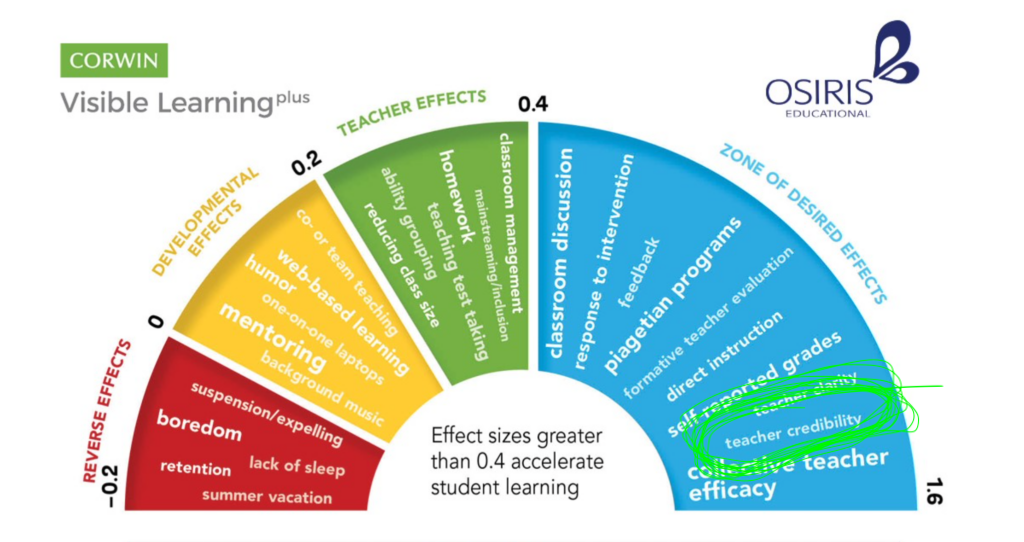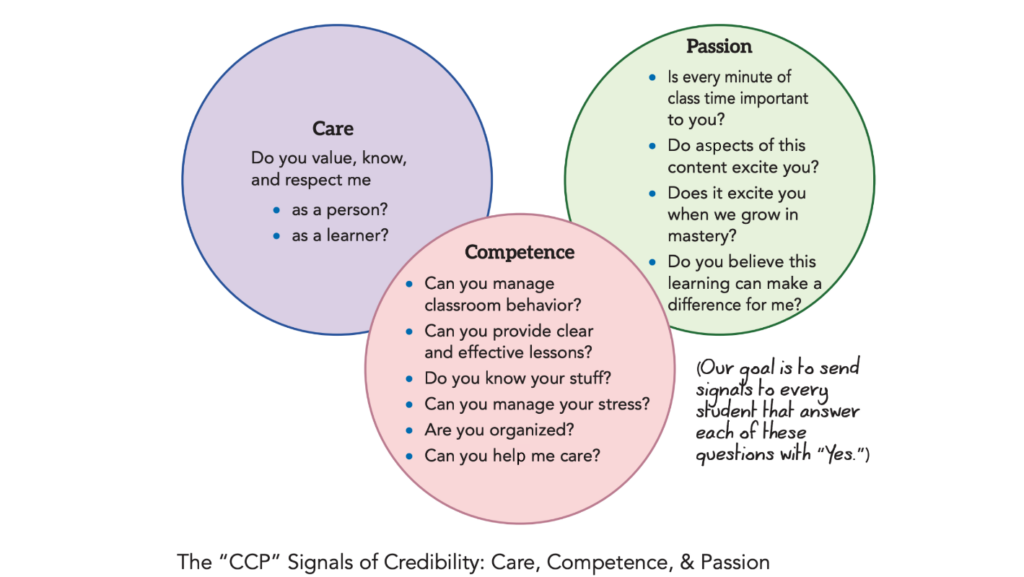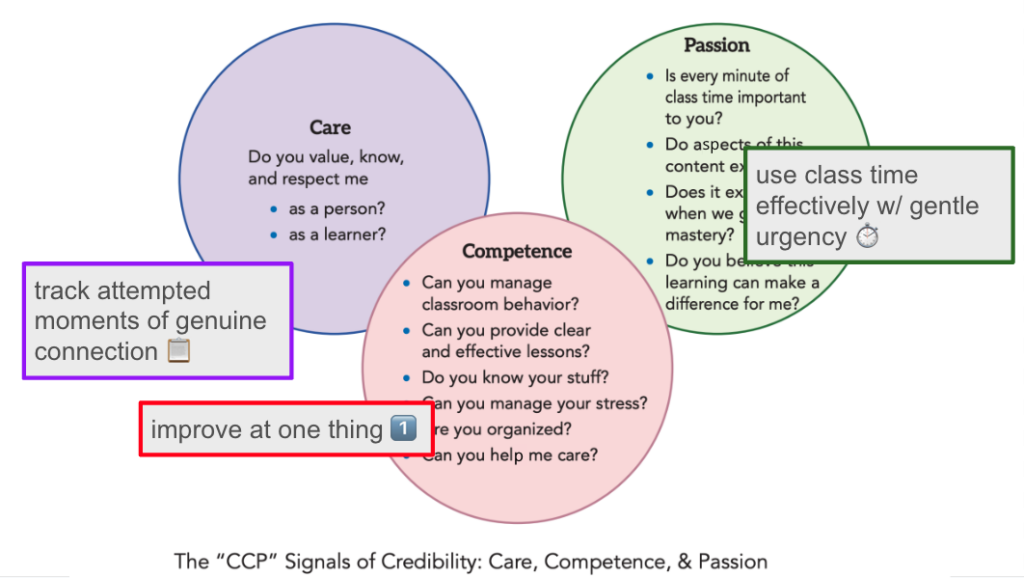Teacher Credibility is the first of the Five Key Beliefs of student motivation, which I unpack at length in The Will to Learn: How to Cultivate Student Motivation Without Losing Your Own and in Chapter 2 of These 6 Things: How to Focus Your Teaching on What Matters Most.
- What Is Teacher Credibility?
- The Key Ideas About Teacher Credibility
- How Can I Cultivate Teacher Credibility in My Classroom?
- Extra “Booster” Strategies for Teacher Credibility
- Common Questions and Hangups About Teacher Credibility
- What are the most common ways teachers unintentionally undermine their own Credibility?
- Should I talk to my students about my Credibility?
- One of the teachers I work with is bad at their job. Does this hurt my Credibility, too?
- I'm brand new to teaching and feel like I'm incompetent everywhere. So…I'm done for, right?
- I hate what I'm teaching. How am I supposed to signal passion about it?
- I think I sent a lot of anti-Credibility signals to my students early in the school year. I'm done for, right?
What Is Teacher Credibility?

Teacher Credibility is the foundation of the Five Key Beliefs methodology. When I am Credible with my students, I have a great shot at influencing:
- The degree to which they Value my subject and the hard work it entails
- The degree to which they are willing to do the work of learning (Effort) and experience the success of growth in that work (Efficacy)
- The degree to which I can help them believe they Belong here
And don't just take my word for it. In the largest meta-analytical research effort ever undertaken in education, researcher John Hattie finds that Teacher Credibility has a massive effect size (see graphic below).

So it's a big opportunity for us. How do we influence it?
The Key Ideas About Teacher Credibility
Key Idea #1: You are always sending signals to your students that impact your Credibility.
Teachers are like cell phone towers. A cell tower is always sending signals, whether my cell phone is on or off. That is the cell tower's job. When it stops consistently doing that job, I'll find the cell company non-credible and take my business elsewhere.

In terms of Credibility, I am always sending signals to my students, whether I want to or not. With what I do and don't say, how I do and don't act, what I am and am not able to do — I'm sending signals to my students, and as they receive these signals, they come to (often unconscious) conclusions about my degree of Credibility.
Key Idea #2: The signals to focus on are as simple as CCP: Care, Competence, and Passion.
While there are many formulations of how Credibility is developed in the heart of a student, my summary of these is simple: CCP.
- Care
- Competence
- Passion
In the image below, I add granularity to these three main signal types. Many teachers (myself included) use this CCP graphic to periodically self-assess on the kinds of Credibility signals we send or fail to send.

If you're armed with these two key understandings — 1) teachers are signal-senders, and 2) Credibility cultivation is as simple as CCP — then you're ready to start doing something with your students.
What, then, should we do?
How Can I Cultivate Teacher Credibility in My Classroom?
At the end of this section, you'll see a list of articles I've written over the years sharing dozens of ways that you can improve your Credibility with students. But when I wrote The Will to Learn, I was determined to identify the fewest, biggest-bang-for-your-buck strategies I could. I narrowed and narrowed and narrowed until finally I had arrived at three core strategies, one for each of the CCP components we examined above.

- Strategy 1: Track Attempted Moments of Genuine Connection (MGCs). These are brief (30- to 60-second) interactions with individual students during which you attempt to make a student feel valued, known, and respected. You keep track of these attempts on a clipboard.
- For a detailed treatment of this strategy, see pp. 47-63 in The Will to Learn, pp. 30-32 of These 6 Things, or this DSJR Guide.
- Strategy 2: Improve at One Thing. This strategy is central to all of my writing. Even though I write about quite a few things, I'm only ever pushing myself to improve at one thing at a time. Many of the tools and ideas I write about are at play in any given week of school, but I'm only pushing myself to improve with one tool or idea at a time. This focuses my efforts and yields faster improvement than distributing my improvement efforts too thinly and broadly.
- For a detailed treatment of this strategy, see pp. 64-90 in The Will to Learn.
- Strategy 3: Gentle Urgency. This is all about using class time well and signaling to our students that class time is sacred, while at the same time we are human beings who won't always get it right and sometimes need rest.
- For a detailed treatment of this strategy, see pp. 91-100 in The Will to Learn.
Extra “Booster” Strategies for Teacher Credibility
For more ideas on boosting the Credibility belief in your classroom, the best place to go is the Teacher Credibility Mini-Course. Its brief lessons cover each of the strategies above and seven additional strategies. Group viewing licenses are available for teams or schools that want to watch and discuss the videos together.
Outside of that, here is an ever-updating list of brief articles I've written to describe more Credibility boosters.
- How to Get Through Your Curriculum This Year (Credibility Booster)
- End of Year Credibility Booster: If You Could Improve ONE Thing About Your Teaching From This Past Year…
- End of Year Credibility Booster: Final Moments of Genuine Connection (MGCs)
- Faculty and Staff Door Signs: A Simple School-Wide Credibility Signal
- Credibility/Value Booster: Is that a Treasure Chest I See You Carrying?
- Simple Credibility Booster: Brian Sztabnik's Sermonizing Ritual
- The Teacher's First Test of the Day, Part 2 (Or How to Boost Your Credibility and Sanity with a Clear and Reinforced Start-of-Class Procedure)
- Credibility Booster: Count Down
- Credibility Booster: Fred's Best Line
- Credibility Booster: MGCing the Whole Class in a Single Class Period
- Credibility Booster: Sharing Bits o' Pedagogy
- 20 Simple, Low Stress Ideas for Boosting Teacher Credibility
- What to Do When You Need a Credibility Breakthrough: The Student-by-Student Ground Game
Common Questions and Hangups About Teacher Credibility
What are the most common ways teachers unintentionally undermine their own Credibility?
- There's a fascinating study that looked at this question, which I unpack and link to in this article.
- I also treat this idea here: “Anti-Teacher Credibility: 10 Great Ways to Become Unbelievable (in a Bad Way).”
- You can also check out this video: “The Tacky Ten: What They Are, Why They're Bad, and How to Avoid Them.”
Should I talk to my students about my Credibility?
I do not recommend trying to convince your students that you are Credible. Instead, show them you are Credible by consistently signaling Care, Competence, and Passion.
One of the teachers I work with is bad at their job. Does this hurt my Credibility, too?
For a deeper dive into this question, see this article.
I'm brand new to teaching and feel like I'm incompetent everywhere. So…I'm done for, right?
Nope, you're not done for.
The good news is, you're not incompetent at everything. Consider the last week of your practice:
- Is there a student whose day you made just a bit brighter?
- Is there a new concept you learned in your discipline?
- Did you discover a way of explaining something that worked for a student who had been struggling?
- Is there a neat tidbit or two that you picked up from personal research, about schooling or life or your discipline?
The first step to solving your problem is to remind yourself that you're not sitting stationary. The next and much harder step, of course, is to start improving at these things that are negatively impacting your daily classroom experience. To dive deeper into that, see Strategy #2 in The Will to Learn.
I hate what I'm teaching. How am I supposed to signal passion about it?
In my conversations with colleagues and my reflection on my own teaching, I see two general areas where a dislike of what we're teaching can come from:
- Personal distaste — for example, when I was teaching English 9 a few years back, it took me a while to get over my dislike of Bradbury's style in Fahrenheit 451.
- Professional distaste — for example, a science teacher using a traditional curriculum who believes all learning should be phenomenon-focused; a math teacher given a textbook to teach from who believes in the “experience first, formalize later” method of math instruction; or an English teacher given a curriculum with whole-class text units (e.g., Shakespeare's Romeo and Juliet for a ninth-grade course) who believes that all reading should be student-selected.
Obviously, these two issues have different solutions. For both problem areas, I encourage teachers to begin by trying the “Gimme Ten Reasons It's Good” exercise. In matters of personal distaste, this is often the exercise that can help you get out of the hole. (It's basically a “Valued Within” exercise that you do to yourself to help you cultivate the Value belief for what you're teaching.)
But in matters of professional disagreement, the “Gimme Ten Reasons” thing may not prove much help. If it doesn't and you keep teaching something that you believe is wrongheaded or bad for students, you'll eventually find yourself deeply demoralized. Just as it's harmful to our students' souls when they are required to do things each day that they do not believe in, so too it is harmful to ours.
However, as we see throughout The Will to Learn and the Five Key Beliefs methodology, beliefs are malleable things. They can be changed, given the right knowledge and experience and signals. Before you go seeking another job or career, I recommend that you do the hard work of making sure your professional conclusions are the “correct” ones. It may be that, instead, they are just the closely held opinions of a vociferous segment of teachers on social media.
My background is mostly in ELA instruction, and I remember early on in my researching days being fairly convinced that the only kind of good reading was reading chosen by a student. I thought that whole-class texts were an affront to human dignity and just downright impractical. But then I got curious. I found books like Ariel Sacks’s (2014) Whole Novels for the Whole Class. I gained understanding of the role that knowledge plays in culture development from works such as Daniel Coyle’s (2018) The Culture Code. I learned about broad-level reading comprehension from writings such as Daniel Willingham’s (2006) article “How Knowledge Helps.” Over time, I realized that despite hot-take tweets from prominent voices in the choice-reading world, choice reading had some significant drawbacks when taken to the extremes I once believed in.
So do some extra research, particularly outside of intra-disciplinary echo chambers, before you set your professional views in stone. It’ll make the job a lot more fun and interesting.
I think I sent a lot of anti-Credibility signals to my students early in the school year. I'm done for, right?
Wow — you keep thinking you're done for, don't you? You're not.
There's a lot of hype around the first days of school, as well there ought to be. You don't get a second chance at a first impression, right?
Except that, you do. Every day is a new impression. The good news with Credibility is that it's a long-term game. No matter how your first week goes, or your next week, or the week after that, what matters most is asking yourself, How am I going to signal to my students that I am Credible today? How can I signal care and competence and passion to the individuals I teach right now?
In other words, while it’s true that first days have special characteristics in the hearts of our students, it’s mostly in the humdrum where Credibility is made or lost.
Still got questions?
If you ask a question in the comments section below, I'll answer it and incorporate your question into this article. In other words, you'll get a double whammy: you get your question answered, and you help make this article better for future readers.
Teaching right beside you,
DSJR
Leave a Reply